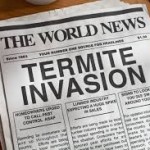Follow Me
Subscribe to My Weekly Newsletter
The Termite Inspection and Report
- Aug
- 04
- Posted by Bregman Properties
- Posted in Blog, Monday Morning Update
The Termite and Your House
 The Termite Inspection: When you buy a house your lender will almost always require a “clear termite report” before they fund your mortgage loan. A “Clear” termite report means that all of the “section one” repairs have been made and that your house is now free from any active infestation.
The Termite Inspection: When you buy a house your lender will almost always require a “clear termite report” before they fund your mortgage loan. A “Clear” termite report means that all of the “section one” repairs have been made and that your house is now free from any active infestation.
More Than Just a Termite Inspection: Although the inspection and report are commonly called the “termite inspection” and “the termite report”, they are more accurately a “Wood Destroying Pests and Organisms Inspection” and “Wood Destroying Pests and Organisms Inspection Report”.
In addition to Drywood Termites and Subterranean Termites, the inspector looks for other wood destroying pests such as wood destroying beetles, fungus, dryrot and water damage. Additionally, the termite inspector will look for existing conditions that may lead to a problem in the future if left uncorrected.
A Two Part Report: The wood destroying pest report will be broken down into two sections. Section one covers repair and remediation (including fumigation, or “tenting”, if necessary) of all currently active conditions and any damage that has already occurred. Section two covers conditions that should be corrected to avoid future damage to your house. Section One = Active. Section Two = May lead to future problems.
Who Pays for Repairs? When you buy a house part of the negotiation process involves specifying who will pay for what. Here in the Southern California area, it is customary that the seller pays for the wood destroying pest inspection and for section one repairs. The buyer is typically responsible for the cost of section two repairs.
Want to Know what your house is worth: Click Here
Let Me Help You Find Your new home: Click Here
Termite Identification
Facts & Identification Information
Termites are often called the “silent destroyer” because they may be secretly hiding and thriving in your home or yard without any immediate signs of damage. All termites consume cellulose-based plant materials. Unfortunately, all homes, regardless of their construction type, can provide cellulose food for termite infestation.
Termites are detritivores, or detritus feeders. They feed on dead plants and trees as well as dead parts of living trees, including wood and wood in the soil. A termite’s mouth is capable of tearing pieces of woody material. This ability is what causes concern in human dwellings: while workers only measure approximately 1 cm to a few millimeters in length, their feeding habits are capable of causing costly damage to property. House foundations, furniture, shelves and even books are all possible feeding sites for termites.
Subterranean termites homes are usually formed in soil. Within these mounds, termites build elaborate tunnel systems and mud tunnels through which they access above-ground food sources. Drywood termites live within the wood they consume and oftentimes infest walls and furniture.
When a colony has matured, winged, swarming termites can be seen around windows and doors. Winged termites are highly attracted to sources of light and are most active in springtime. After mating, these termites locate a new breeding site and create another colony, spreading infestations throughout multiple locations in the case of drywood termites.
What Can You Do to Help Protect Your Home?
Since termites are a constant threat to your home, here are some things you can do during the year to help maintain the effectiveness of your regular maintenance treatment plan. Small steps make a big difference in prevention. Start by eliminating moisture conditions and termite food around your home. These simple steps make your home a less attractive target, helping deter termites.
Eliminate Moisture Problems
- Repair leaking faucets, water pipes, and A/C units
- Divert water from foundation
- Keep gutters and downspouts clean
- Remove excessive plant cover and wood mulch
- Get rid of standing water on roof
- Keep all vents clear and open
- Seal entry points around water and utility lines or pipes
Remove Food Sources
- Keep firewood, lumber or paper away from foundation or crawl space
- Get rid of stumps and debris near house
- Place screens on outside vents
- Check decks and wooden fences for damage
- Wood on your home shouldn’t contact the soil
Warning Signs & Identification
Some indications you may have a termite infestation:
- A temporary swarm of winged insects in your home or from the soil around your home.
- Any cracked or bubbling paint or frass (termite droppings).
- Wood that sounds hollow when tapped.
- Mud tubes on exterior walls, wooden beams or in crawl spaces.
- Discarded wings from swarmers.
 818-915-3360
818-915-3360
